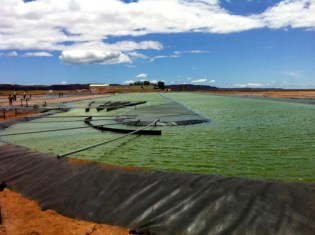
Photo by Drew Bandy.
Protein is directly tied to resource intensity. Vegetarians choose a meatless path to cut down on the vast quantities of land, water, nitrogen, and pesticides required to produce most livestock feed. And many meat eaters are thinking strategically about the greenest sources of animal protein. But what if animals didn’t require pound upon pound of industrially grown corn or soybeans to grow?
One solution might be algae. That’s right — pond scum has promising potential as a source of animal feed, as well as human feed and fuel.
“Algae is really the premiere sustainable source of raw materials for food and feed,” said Jim Astwood, vice president of product management for Aurora Algae, a company that’s been cultivating the plant in the desert of western Australia to explore its commercial possibilities. “The water and land footprint is small compared to traditional agriculture and there’s high productivity.”
Algae can be cultivated in human-made ponds on otherwise unusable desert land, requiring only sunlight and seawater to grow. It’s about 30 times more productive than soy (and 50 times more productive than corn), but requires only 1 percent as much fresh water. It also has a much higher protein content — up to 70 percent, compared with about 10 percent in corn and 40 percent in soy. Replacing at least some corn- and soybean-based livestock feed with algae-derived feed would not only shrink the life-cycle impact of meat, it could free up a lot of land currently devoted to the production of animal feed, making more of it available for crops that directly feed humans instead.
“If we could use this biomass to replace soybeans [in animal feed], then we could have a lot of soybeans for human consumption,” explained Xingen Lei, a Cornell professor who’s been testing algae as an animal feed supplement. (Not that soy doesn’t have its own problems as a protein source.)
The same solution could be applied to aquaculture, an industry growing rapidly with the depletion of natural fisheries. The Organization for Economic Cooperation and Development expects that by 2015, aquaculture will surpass capture fisheries as the primary source of fish for human consumption, and that the industry will be affected by “rising commodity prices in general and the impact on producers, e.g. soybean prices influencing the price of fish feed and the price of farmed fish.” Algae’s extremely low impact compared to soy and corn could make it an ideal sustainable ingredient in fish feed, and could help keep farmed seafood prices from skyrocketing in response to volatile crop markets.

An Aurora Inc. algae pond.
Lei’s research is funded by a $5.5 million government grant to investigate algae’s role in solutions to looming food and energy crises. The U.S. government funded research into algae’s potential as a biofuel for almost two decades, but discontinued the program in 1996 after concluding that algal biofuels could not be cost-competitive with fossil fuels. But oil prices have risen so much since then that algae has received renewed attention from investors as a potential fuel source. Charles Greene, another Cornell professor who leads a multi-university consortium studying algae cultivation in Hawaii, wrote in an email that “even with today’s high fossil fuel costs, algal biofuels will likely become cost competitive with [fossil fuels] only when valuable [algae] co-products are simultaneously exploited and commercialized.”
In other words, the process of producing biofuel from algae leaves behind biomass that would otherwise go to waste. But converting that byproduct to commercially viable feed instead increases the overall value of algae as a resource. That’s why algae’s animal feed application is so significant – it gives algal biofuel a value-added component that makes it much more attractive to investors. What’s more, extracting oil from algae for fuel increases the protein content in the remaining biomass, making it potentially more ideal as a feed source.
“Most calculations [of the cost of algal fuel] do not factor in the animal feed application,” Lei said. “If you put that in, the equation would shift significantly. It’s mutually beneficial.”
In addition to protein, algae contains omega-3 fatty acids, an important nutrient for human survival. We think of omega-3s as coming from fish — we’re told to take fish oil supplements or eat salmon or sardines in order to get a healthy dose. But as Astwood explains: “Fish don’t make omega-3s, little fish eat crustaceans that eat algae. Algae is the source of omega-3s.” Since algae is at the base of the food chain, using it as a source of omega-3s and protein for humans would also greatly reduce the risk of mercury contamination that occurs in tuna and other fish higher up on the food chain (mercury bioaccumumlates, or increases in the concentration as you go up the food chain). And in the health food world, algae-derived protein could offer a less-processed alternative to currently popular supplements like soy protein isolates.
As if all that weren’t enough, algae’s appetite for carbon makes its cultivation process virtually carbon-neutral, if not carbon-negative, as the tiny aquatic plants could actually help remove carbon dioxide from the atmosphere.
It might sound too good to be true — and, like all industrially produced foods, “big algae” could very well have its downsides. But it will likely be a while before we know what they are. Astwood said Aurora, his company, hopes to break ground on commercial facilities later this year (they’re currently in the prototype stage). Lei’s team is still working to find the best algae strains for use in animal feed. And Greene said funding still presents a huge barrier; moving pilot projects to a commercial scale would require hundreds of millions of dollars. In other words, if only quite so many federal dollars weren’t flowing to oil companies, algae might have half a chance.



